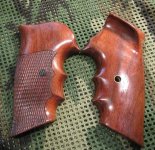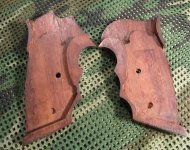Tempering of spring steel is accomplished at relatively low temperatures, around 450 to 700 degrees F. At these temperatures, steel still retains 100% strength. If you heat a spring back up to those temperatures, they will lose their spring.

True, but my rationale is that if the springs INSIDE the revolver got that hot, how hot did the frame and cylinder have to get - in order to transfer that much heat into those springs? The obvious answer is A LOT HOTTER.
How hot? I certainly don't know. Do you? Does anyone?
Kinda' seems like one of those "do ya' feel lucky" scenarios to me.
I respect your expertise in all things S&W, but forgive me for saying that no one is an expert in everything.
I gave the advice I did because I believe it is better to play it safe rather than to be sorry. I err on the side of caution, and I stand by that opinion.
Apparently you are of a different opinion. That's OK. We can agree to disagree. The OP has to make the decision for himself - based on the differing opinions and info he can gather.
One other note: the final tempering of a spring IS done at relatively low temps - 450-700 degrees F, as you noted.
HOWEVER, that "final tempering" step comes AFTER the initial heat treatment applied to make spring steel. THAT initial heat treatment step requires quite a bit higher temperatures, and those high temps are immediately followed by a quick quench (rapid cooling). It is the much higher temps - followed by rapid cooling - that makes the steel of a spring hard enough to be "springy".
Once that initial hardening of the spring is complete, THEN the relatively lower temps are applied to "temper" the spring steel. This step increases ductility of the spring by softening the outer layer of the steel - which increases the spring's durability.
BUT it is still the initial application of HIGHER temps that makes the inner steel of the spring hard enough for it to be "springy".
So, if the springs INSIDE the revolver have lost their "springy" qualities, it stands to reason that the whole revolver has been exposed to temperatures high enough to remove any and all tempering, and that means the strength of ALL of the revolver's steel has been compromised.
Or at least that is how I understand it. If I'm wrong, then I'm certainly open to being corrected. I'm always willing to learn.


